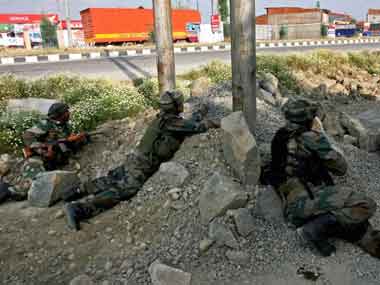Fourteen years have passed, almost to the month, since Union defence minister George Fernandes promised Pakistani infiltrators in Kargil would be “flushed out in forty-eight hours”. He said, one day later, that the army “had cordoned off the area entirely” and that Indian objectives would be realised “within the next two days”. It took two months and nine days-and the lives of hundreds of India’s finest men–before the war was won. The whole sordid story of how high officials sent officers and men to their deaths in an effort to hide their incompetence has since become known. Kargil, not surprisingly, hangs like a ghost over Pakistan’s Shala Bhata incursion. [caption id=“attachment_1150175” align=“alignleft” width=“380”]  Fighting enemies. PTI[/caption] In New Delhi, officials insist that the intrusion into Shala Bhata, near Keran in Kashmir’s Kupwara district, is no Kargil. They’re right: that time, the intrusions ranged across hundreds of kilometres, and involved division-sized forces. Three lessons are key–and, unless politicians come clean with the country on just what is going on and what they mean to do about it, the risks of further crisis ahead are very real. First, this isn’t a infiltration, this is a full-blown incursion: The army has publicly cast this as just a larger version of the kind of jihadist infiltration which takes place all the time along the Line of Control. However, there’s plenty of reason to believe that isn’t the case. From yesterday’s press conference by Lieutenant-General Gurmit Singh, the XV corps commander, we know that the intruders have been firing on Indian troops for ten days, after what was seen as an infiltration was first blocked. Had infiltration into Jammu and Kashmir been the objective, the intruders would have tried to pull back at that point. Instead, more kept coming–including people Lieutenant-General Singh has said he thinks are Pakistani special forces personnel. This is an intrusion intended to send a message–not just another infiltration attempt. Its worth noting, parenthetically, that this kind of thing has happened before. In 1989, for example, Pakistan seized control of the Dalunang heights in Kargil’s Kaksar sector. Colonel Anil Shorey has told the story of India’s ill-fated attempts to retake the heights, a conflict the media did not discover for years afterwards. It was only in 1999 that Dalunang was retaken. Second, there’s plenty of method in the Pakistan Army’s madness: The Shala Bhata incursion needs to be read in its context. Ever since 2008, when Ashfaq Parvez Kayani took over as Pakistan’s army chief, there has been a a steady escalation steadily escalation of hostilities on the Line of Control. Things reached new heights in recent months, with a series of incidents like the macabre beheading of two Indian soldiers, and the subsequent execution-style killings of five more. There’s good reason to believe, though, that the Indian Army’s been dishing out as good as its got: in recent weeks, army sources say, at least two Pakistani posts in the Mendhar sector have been obliterated in Indian offensive action, and another three rendered in-operational by sustained fire. The Shala Bhata incursion may be intended to signal the Pakistan army is willing to up the stakes–and to test just how far a war-averse Indian security establishment is willing to go to assert dominance on the Line of Control. Third, this operation may not drag out much longer–but there’s a high probability of more trouble ahead. Army sources are telling Firstpost there’s some signs the intruders have pulled back–possibly in response to the realisation among Pakistan’s generals that the media outcry will force harsher action. The Indian Army, though, still hasn’t recovered the bodies of intruders it says its killed. This gives us some idea about the slow progress of Indian army operations. Lieutenant-General Singh announced the killings of the intruders several days ago. That the bodies haven’t been recovered could mean one of two things: either Indian troops have been unable into the areas where the intruders’ bodies are, or the intruders have a logistical line open into Pakistani-occupied Kashmir and have evacuated the corpses. Either way, this operation hasn’t exactly covered itself in glory. The lack of a firm retaliatory response is likely to embolden Pakistani strategists–and that’s very bad news for India.
This is no infiltration attempt: its a full blown intrusion, meant to send a signal to India. If there isn’t a very firm retaliatory response, it will only embolden Pakistan’s generals.
Advertisement
End of Article


)

)
)
)
)
)
)
)
)



